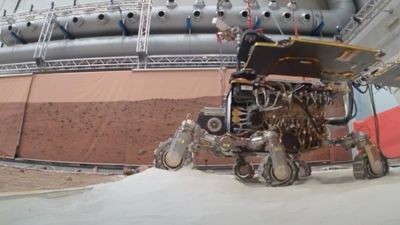Stevenage-built ExoMars Rover escapes sand trap in Mars mission simulator

According to ancient Chinese philosophy, a journey of a thousand miles begins with a single step - now the European Space Agency (ESA) is ensuring a journey of 230 million miles doesn't end with one.
The Stevenage-built ExoMars Rosalind Franklin rover is due to blast off to Mars next year. Engineers are testing it to see if it can overcome one of the biggest dangers it will face when it lands on the Red Planet.
Rovers on Mars have previously been trapped in sand. It can be difficult to extricate as turning wheels can dig the vehicle deeper. To avoid this The Rosalind Franklin can actually walk out of trouble.
The technology allows the vehicle to wheel-walk giving good traction in soft soils and high slopes, such as dunes.
Engineers have been busy testing the technology. In the test the rover had its front two wheels almost completely buried in sand, but easily escapes using the wheel-walking mode.
More about ExoMars
What is the ExoMars mission?
What is the ExoMars mission?
The ExoMars programme is a joint project between the European Space Agency and the Russian space agency, Roscosmos.
It wants to try to answer the question of whether life has ever existed on the red planet. The mission name is made up of the planet, and Exo referr to the study of exobiology – the possible existence of life beyond Earth.
What does the ExoMars Programme consist of?
What does the ExoMars Programme consist of?
There are two missions. The first, launched in March 2016, consists of the Trace Gas Orbiter (TGO). The TGO will search for evidence of methane and other trace atmospheric gases that could be signatures of active biological or geological processes.
The second mission will see the Stevenage-built Rosalind Franklin rover launch in 2022 with a Russian surface platform, Kazachok, to the surface of Mars. It will travel across the Martian surface to search for signs of life. It will collect samples with a drill and analyse them with next-generation instruments.
How does will the Rosalind Franklin Rover operate?
How does will the Rosalind Franklin Rover operate?
It uses solar panels to generate power, and is designed to survive the cold Martian nights with the help of batteries and heater units.
It is highly autonomous. Scientists on Earth will designate target destinations, but the Rosalind Franklin will navigate itself - by making digital maps from pictures captured by its cameras.
What will it do?
What will it do?
Rosalind Franklin will look for signs of life. It will do this by autonomously drilling to the required depth (maximum 2m) and collecting a small sample. This sample will be delivered to the analytical laboratory in the heart of the vehicle where it will be crushed into a fine powder and then detailed chemistry, physical, and spectral analyses will take place.
Isn't NASA already there?
Isn't NASA already there?
NASA landed its Perseverance rover on Mars back in February. Its mission is to seek out signs that microbial life once existed on the planet, it will be collecting a range of samples which will then be returned to earth for study.
Stevenage-based Airbus Space and Defence is working on a probe which will do just that as part of a European Space Agency project.
NASA is also keen to gather knowledge which could help a manned-mission to the red planet.
“We hope to never need to use wheel walking on Mars to escape dangerous sand traps, but we are glad to have such functionality to potentially safeguard the mission,” said Luc Joudrier, ESA ExoMars Rover Operations Manager. “From a rover operational point of view, this is really our insurance against difficult terrains.”